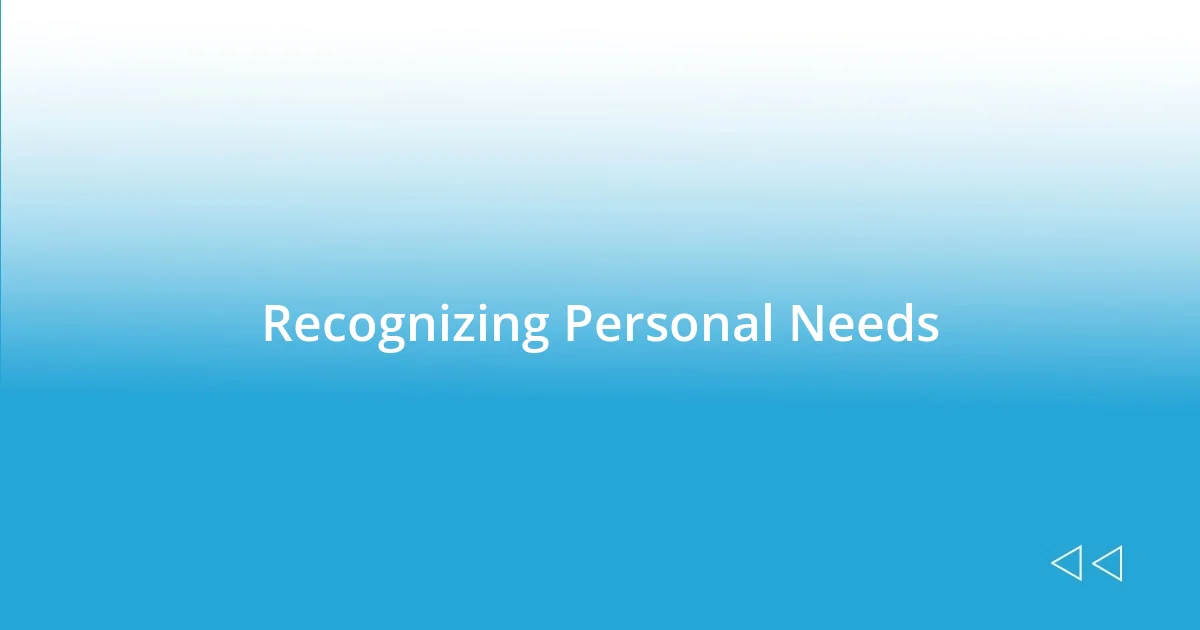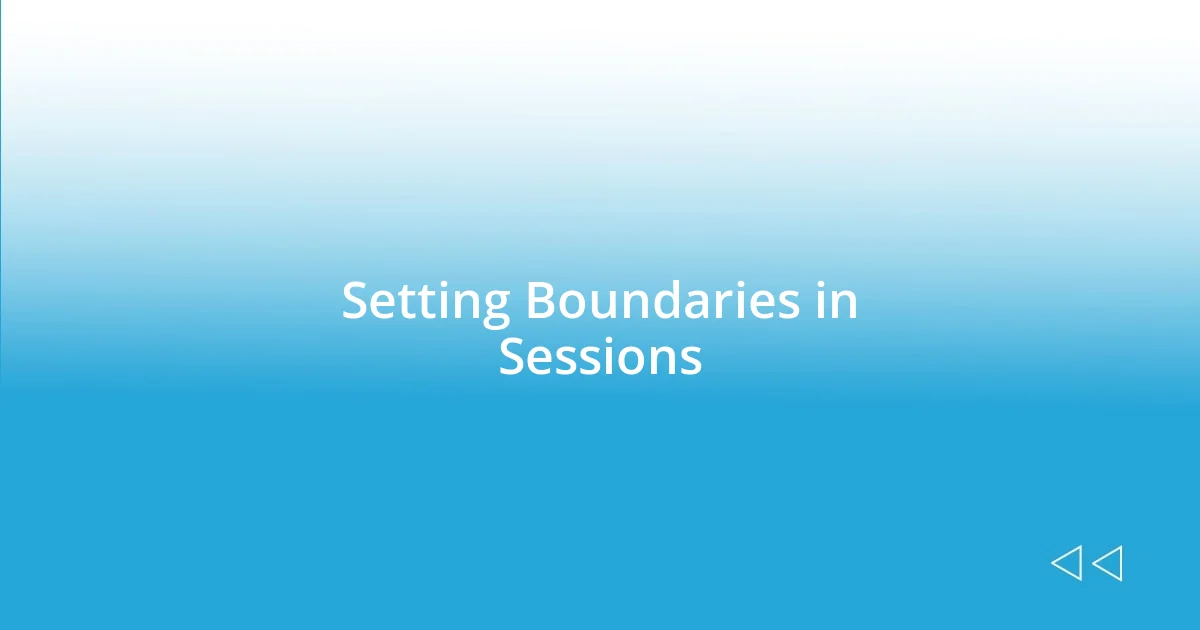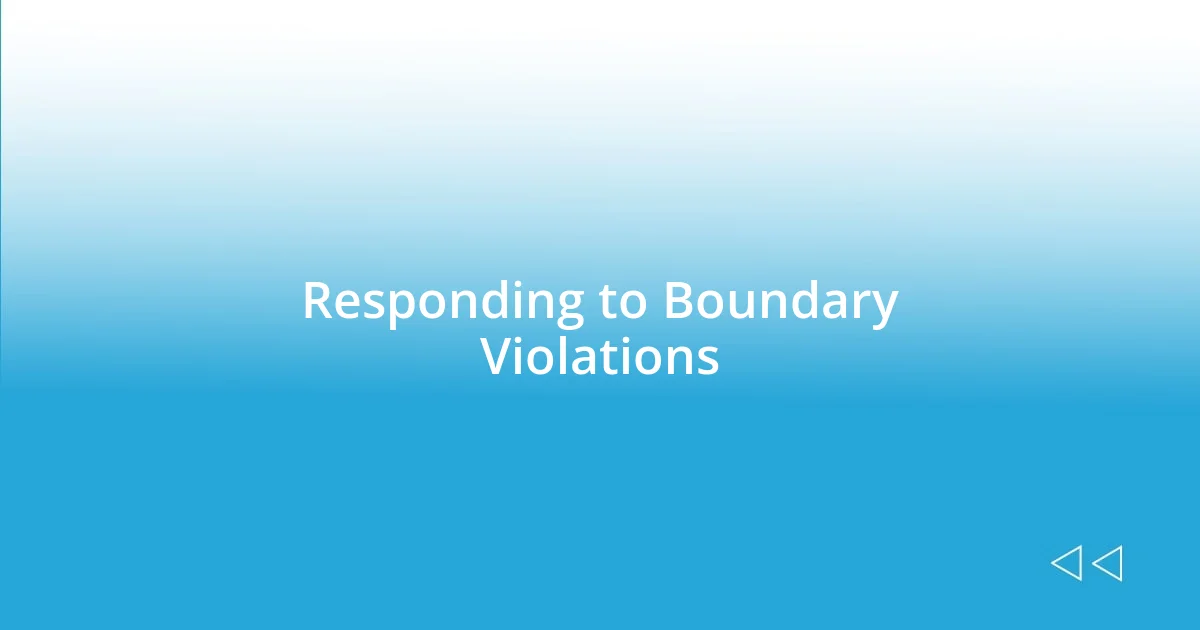Key takeaways:
- Establishing emotional boundaries is crucial for self-protection and progress in therapy, allowing for healthier relationships and a safe space to explore emotions.
- Effective communication of boundaries involves being direct, using “I” statements, practicing active listening, and adapting these boundaries as needs evolve.
- Reflecting on the impact of boundaries can foster personal growth, enhance the therapeutic relationship, and empower individuals to voice their needs confidently.

Understanding Emotional Boundaries
Emotional boundaries are essential in therapy. I remember the very first time I discovered my limits; it felt like lightbulbs going off in my brain. Suddenly, I understood that it wasn’t just okay to protect my feelings—it was necessary to make progress.
Setting emotional boundaries allows you to define what is acceptable in your relationships. I often asked myself, “How much of my emotional energy am I willing to give to others?” This practice helped me recognize when I was overextending myself and ultimately led to healthier interactions in my life.
It’s fascinating how many people believe that emotional boundaries are selfish. I used to share that misconception, feeling guilty for wanting to keep certain feelings at bay. Yet, in my journey through therapy, I learned that these boundaries are not walls to shut people out but rather gates that help me feel safe as I explore my emotions.

Recognizing Personal Needs
Recognizing my personal needs was a pivotal step in my therapeutic journey. Reflecting on what I truly required in my sessions forced me to confront my own discomforts. For example, there were moments when I realized I needed a specific type of support, yet I hesitated to vocalize it. It took practice and encouragement from my therapist, but gradually, I learned that identifying these needs was not only healthy but vital for genuine progress.
In therapy, I also discovered the significance of listening to my body. There were days when I felt drained or anxious before a session, and these physical sensations served as important indicators of my emotional state. For instance, the simple act of noting when my chest felt tight helped me articulate that I needed a more gentle approach that day. This process honed my ability to tune into my experiences and respond with compassion towards myself.
Understanding my personal needs also meant recognizing patterns in my interactions. I started to see when I was continuously giving my time and energy to others without replenishing my own reserves. For instance, I’d often stay late after group therapy to support friends, disregarding my own exhaustion. Identifying this trend prompted me to set clear limits on how much I would engage, to ensure that I could foster healthier relationships while still caring for my own emotional well-being.
| Type of Need | Example from My Experience |
|---|---|
| Emotional Support | Realizing I needed to voice my need for encouragement in challenging conversations. |
| Physical Awareness | Noticing when my body felt tense as a signal to adjust the tone of the session. |
| Time Management | Recognizing my tendency to support others at the expense of my own rest. |

Communicating Boundaries Effectively
Communicating my boundaries effectively was undoubtedly a journey of self-discovery. I remember the first time I mentioned to my therapist that I needed more time to process heavy topics before diving in. It felt vulnerable, yet freeing. That moment taught me that sharing my needs isn’t just about voicing discomfort; it’s about fostering an environment where I can thrive.
To communicate boundaries effectively, consider these steps:
- Be Direct: Clarity is key. I found it helpful to state my needs as simply as possible.
- Use “I” Statements: This approach allows me to express my feelings without sounding accusatory. For instance, I would say, “I need to take a break,” rather than “You’re overwhelming me.”
- Practice Active Listening: Honoring the space of others while sharing my boundaries greatly enhanced our dialogue. It built empathy and understanding on both sides.
- Set a Tone of Respect: I learned that framing my boundaries with positive intentions, like “I want to ensure we make the most of our time together,” fosters a supportive atmosphere.
- Revisit as Necessary: Sometimes, I realized that my boundaries would evolve. Regularly reassessing what I needed helped me communicate changes in a constructive manner.
Being open about my boundaries transformed my therapy experience. It made me feel more in control and secure, opening the door to more fruitful sessions.

Setting Boundaries in Sessions
Sometimes, setting boundaries during sessions felt like walking a tightrope. I recall a time when I was overwhelmed by heavy topics, and instead of continuing to push through, I paused and admitted to my therapist that I needed a moment to breathe. It was a simple request, yet it transformed our dynamic, allowing me the space to process my thoughts without feeling rushed or pressured. Have you ever felt that same weight of expectation? Trust me, acknowledging that need can be a game changer.
As I grew more comfortable in therapy, I began integrating boundaries into my sessions more naturally. There was a period when I realized that discussing certain sensitive topics too frequently left me emotionally drained. So, I decided to share this with my therapist, saying, “I’ve noticed I need some time away from exploring those feelings.” Not only did this strengthen my ownership of the process, but it also laid the groundwork for more targeted discussions. I felt empowered, as if I was the architect of my own healing.
In truth, I found that setting boundaries wasn’t just an act of self-preservation; it was also an invitation for deeper connection. When I established guidelines around the types of conversations I felt safe exploring, it allowed my therapist to better navigate our sessions. I think about the moments when I clearly articulated my needs; it felt like clearing a fog. Isn’t it incredible how setting these limits can lead both the therapist and client toward a more profound, shared understanding?

Responding to Boundary Violations
Boundary violations can be incredibly challenging to navigate, but how you respond can make all the difference. I vividly remember a session when my therapist unintentionally pushed me into a sensitive topic I wasn’t ready to explore. I felt a rush of anxiety; my instinct was to retreat, but instead, I took a deep breath and firmly told him, “I need us to approach that later.” It was a powerful moment that taught me the importance of standing firm in my boundaries.
On another occasion, a breach of trust occurred due to a therapist’s excessive personal sharing. I felt uncomfortable and questioned how to address it without sounding rude. Ultimately, I calmly expressed, “I value our space, but I’d prefer our focus to stay on my experiences.” This moment forced me to realize that asserting my boundaries wasn’t just about protecting myself; it was also about cultivating a space where healing could truly flourish. Why should I compromise on the very environment that is supposed to support my growth?
Each time I faced boundary violations, I learned that my feelings were valid, no matter how uncomfortable addressing them felt. It’s a journey of understanding that protecting my mental space is not just an option; it’s essential for effective therapy. Through these experiences, I discovered the strength within each conversation, reinforcing the idea that responses to boundary violations can ultimately enhance the therapeutic relationship. How do you respond when your boundaries are challenged? I hope you find the courage to voice your needs, just as I did.

Adapting Boundaries Over Time
As my therapy journey progressed, I realized that boundaries are not static; they evolve as we do. I remember a phase when I started feeling more expressive, leading me to adjust my boundaries to allow for deeper emotional explorations. One day, I shared with my therapist, “I’ve realized that I’m ready to tackle these feelings more directly.” This shift marked a turning point, not just in my sessions but in how I perceived my own emotional landscape.
Adapting boundaries also required me to remain attuned to my emotional states. There were times I felt lighter and more open to discussing heavier topics, but other days, I needed to pull back. Recently, I found myself saying, “I’m feeling a bit fragile today; let’s keep it light.” This adaptability created a rhythm in our sessions, allowing me to express my needs without hesitation. Have you ever felt that freedom to adjust your boundaries based on what you need most?
Embracing the reality that my boundaries could shift over time deepened my trust in the therapeutic relationship. I noticed the more I communicated about my evolving needs, the smoother our conversations became. I think back to when I first struggled with this concept—wondering if it was unusual to change my mind. Ultimately, I discovered that therapy is fluid; it grows with you, shaped by your experiences and insights. How liberating it is to know that adjusting my boundaries was not a weakness but a strength in my healing journey!

Reflecting on Boundaries Impact
Reflecting on the impact of boundaries in therapy has been an eye-opening experience for me. I distinctly recall moments when my ability to firmly articulate my limits changed the dynamic of our sessions. For instance, after expressing discomfort with certain topics, I noticed not only a shift in my stress level but also a newfound respect in our conversations. Have you ever felt that relief wash over you when you finally voiced a concern? I certainly did.
The clarity that emerged from these boundary-setting moments was empowering. I learned that my voice matters just as much as the therapist’s guidance, and that shift altered how I viewed myself in the therapeutic space. Looking back, I remember a particularly vulnerable moment when I stated, “Sometimes I just need quiet time to process things.” That statement not only validated my feelings but also highlighted the necessity of patience in therapy. This kind of reflection can catalyze real change, don’t you think?
As I delved deeper into my journey, I recognized boundaries as more than just protective measures; they became a roadmap for my personal growth. In fact, after establishing clear limits around my emotional availability, I began to flourish. Each session became an opportunity to explore and expand within a safe framework. This experience taught me that reflecting on the established boundaries isn’t merely a task; it’s an essential part of nurturing the healing process. How has your reflection on boundaries shaped your own journey?
















